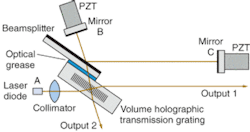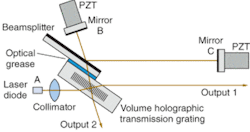Tunable laser diode has ultranarrow linewidth
Narrow-linewidth tunable laser diodes can be of great use in spectroscopy. Given a gain medium of some spectral width, narrow-linewidth tuning is desirable across the whole gain range. Usually, narrow-linewidth operation involves additional losses and limits the tuning range because the gain weakens at the spectral edges. Now, researchers at the Universität Mainz (Mainz, Germany) and the Gesellschaft für Schwerionenforschung (Darmstadt, Germany) have developed a transmission-grating external-resonator setup for laser diodes that allows ultranarrow-linewidth operation across the full spectral gain range.1 In addition, a laser of this type has been introduced as the reference into a wavemeter, stabilized to a cesium resonance.2
In laser resonators, reflective gratings are usually used for coarse wavelength selection and tuning, mostly either in the Littrow configuration (in which optical feedback is obtained from the first-order reflection) or in the Littman configuration (in which the radiation diffracted into the first order is retroreflected by a mirror for optical feedback). In the latter configuration, tilting of the mirror scans the wavelength without changing the direction of the laser beam, which is coupled out in the zeroth order-an advantage of the Littrow configuration. For further linewidth narrowing, as required for high-resolution spectroscopy, additional wavelength-selective optical components must be combined with the grating that, ideally, is of the transmission type, permitting optical components on each side.
Transmission gratings, however, usually suffer from low diffraction efficiency into the order used for optical feedback. But, as with reflective gratings, transmission gratings can be blazed by making the direction of diffraction coincide with that of reflection at the grooves, considerably enhancing the diffraction efficiency into the selected order. To realize a blazed transmission grating, the Mainz-Darmstadt team cooperated with the Institut für Hochtemperatur-Thermodynamik at Technische Hochschule Aachen (Aachen, Germany). By exposing a photosensitive medium (a thin sheet of dichromate gelatin) in a standing-wave interference pattern in a holographic setup, they made a volume grating consisting of 20-μm-wide dielectric layers of alternating refractive index, protected on both sides by glass sheets.
In a first prototype, the volume-holographic transmission grating was implemented in a Littman-type resonator using a laser diode emitting up to 15 mW in a spectral band around 852 nm. The direction of the beam diffracted by the alternating-index layer stack came close to matching the direction of reflection caused by the layers (the blaze condition), so that efficient optical feedback to the diode was obtained. Under this condition, small grating rotations have negligible influence on the selected wavelength, but change the direction of reflection twice. Therefore, the feedback efficiency can be continuously varied from its maximum to an arbitrary lower level and hence can be optimized for intensity and spectral bandwidth within the limits of the grating resolving power.
In particular, the feedback can be optimized to allow laser oscillation far from the center of the gain curve. For an experiment to be performed with calcium ions and cesium atoms, diode lasing could be excited 2 nm off the gain maximum, with a linewidth determined to 35 kHz at the optimum. The feedback optimization is in contrast to ordinary Littman resonators with reflective gratings, where the feedback cannot be changed independently of wavelength tuning.
External resonator
The researchers combined the Littman setup with an enhanced external planar resonator to achieve further frequency narrowing (see figure). An 80% reflective beamsplitter was optically contacted to the grating, allowing coupling between the external and laser resonators. Both resonators were adjusted to equal lengths of 5 cm, corresponding to a 3-GHz free spectral range. Achieving resonance ensures that both resonators are tuned synchronously; the resonance condition is maintained during a frequency scan without any electronic feedback. Because of resonance the splitter does not introduce an optical loss, but fixes the external resonator with its high finesse as the effective optical feedback. The resonator is extremely selective with respect to the angle of the laser beam. The grating transforms the angular selectivity to frequency selectivity, favoring a single longitudinal mode of the resonator.
The outputs of two identical external-cavity free-running lasers could be superimposed, giving rise to a beat signal in the megahertz range. The signal was Fourier analyzed, allowing for a 0.1-ms integration time. The beat signal’s half-width of 11 kHz corresponds to a 5.5-kHz laser linewidth, assuming Lorentzian line shape, or 8 kHz for a Gaussian line shape. The laser could be operated ±5 nm away from the center of the gain curve; mode-hop-free tuning was possible over about 3 GHz.
REFERENCES
1. G. Ewald et al., Appl. Phys. B80, 483 (2005).
2. S. Götte et al, Rev. Sci. Instr. 75(4), 1039 (2004).

